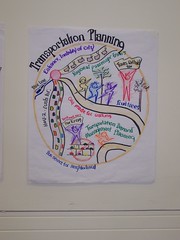Transportation Planning and the Policy Greenhouse
No one is a harsher critic of me than me... and so I have to judge my presentation at last Friday's Policy Greenhouse a failure. (See the entry on Greater Greater Washington for more on the session generally.)
I know better, I should have only said one or two things.
I tried to do way too much (as is my wont). Instead I tried to say 20. So rather than those 20 things, here is what I should have said:
1. DC's spatial form was designed specifically (during the Walking City [1800-1890] and Transit City [1890-1920] eras) to optimize walking, bicycling, and transit.
2. So the spatial form combined with a rich transit infrastructure, is the foundation of DC's competitive advantage within the Metropolitan region
3. that the city needs to plan its own transportation future accordingly--and cede responsibility for this to either the MWCOG or to WMATA
4. institute a transit withholding tax--and why a congestion charge doesn't make sense
5. subway expansion
and left it at that.
Now a couple of well placed government officials did comment to me that they hadn't thought before of how I expressed that DC's spatial form was created to optimize walking, bicycling, and transit.
So on that basis, I won't judge my presentation a total loss. (But I have learned that I am going to have to bite my tongue about comprehensive and complete models when the situation is for something much more bite sized and digestible.)
Because I only had 5 minutes, I didn't go into detail about why a congestion charge in DC doesn't make sense:
1. Much of the worst congestion in the region is not in DC, it is in the suburbs.
2. Unless a congestion charge is accessed regionally, it will have limited effect on congestion regionally.
3. And except for certain roads at certain times of the day, DC streets aren't that congested (see the WMATA subway and bus system for the answer to that point). So why does DC need a controversial charge that will raise all kinds of cain?
4. And if a congestion charge is only accessed in DC, we can't trust the suburbs--including Arlington County, which we love as a national best practice example, but at the same time, they provide incentives for businesses leaving DC such as the Bureau of National Affairs--to not use that against DC in terms of recruiting businesses and agencies currently located in the city.
Instead, a transit withholding tax--such is assessed in certain counties in Oregon now, and will be added to help fund the MTA in the NYC region--could generate upwards of $200MM annually, and be assessed on everybody working in DC, rather than only those people driving into DC.
It could fund subway, streetcar, and light rail expansion within the city, certain bus system improvements, and yes, certain road improvements.
It would be assessed on employers, and for it to make a difference, each of the branches of the federal government would have to agree to its assessment. This is a huge barrier to the imposition of the tax.
As in Oregon, it would be paid by employers.
-------------------
Image: visual produced live by an artist, during the presentation at the Policy Greenhouse event.




0 Comments:
Post a Comment
<< Home